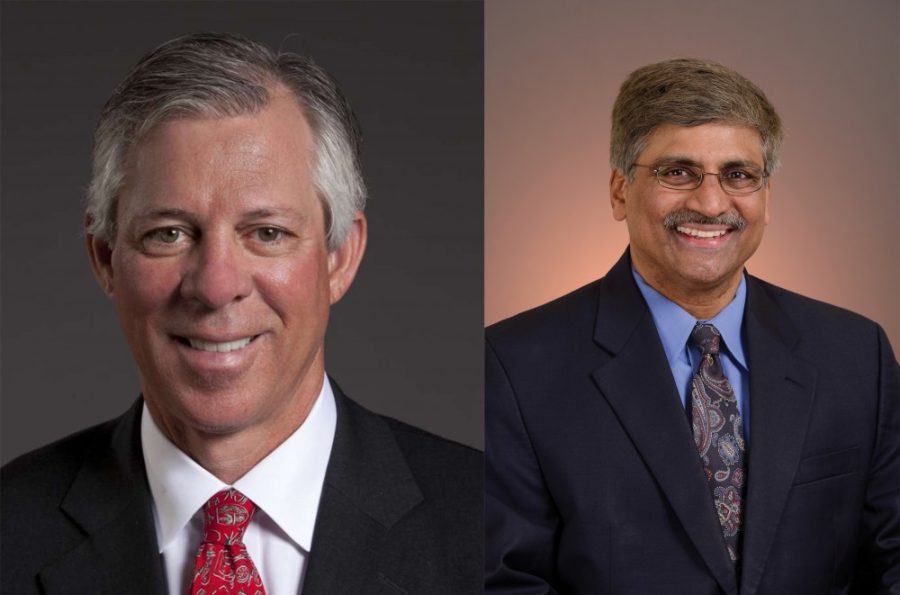The board hiring the University of Arizona’s next president is meeting Monday for final interviews with the two remaining contenders, one of whom may have a lot to lose if he gets the job.
Dr. Robert C. “Robby” Robbins is a million-dollar man in his current post as president and CEO of Texas Medical Center, Arizona Daily Star research shows.
Robbins’ office wouldn’t provide his salary, but the medical center’s nonprofit tax records show he earned nearly $1.2 million in 2014, the most recent figure available online.
The other UA finalist, Sethuraman “Panch” Panchanathan, earns $447,400 as an executive vice president overseeing research, innovation, entrepreneurship and economic development efforts at Arizona State University.
Panachanathan’s income would increase by 50 percent, while Robbins’ would drop by about 50 percent, if they earned the same as current UA President Ann Weaver Hart, whose pay package totals $670,000 this year.
None of Arizona’s university presidents makes $1 million. ASU President Michael Crow comes closest with a pay package totaling $788,000 this year.
It isn’t clear if the Arizona Board of Regents considered potential salary expectations when choosing the two finalists, or whether the board would consider increasing the pay level for the UA president.
Regents haven’t answered those questions. Nor have they provided a rationale for why the board plans to eliminate one of the two finalists by Tuesday, leaving only the winner to visit the UA campus community on Wednesday.
They also won’t say who was on the short list of presidential contenders, prompting criticism that regents are ignoring an Arizona Supreme Court ruling that requires everyone interviewed for a state university president’s job to be publicly identified.
The two UA finalists also aren’t commenting for now.
The Star asked each for a 10-minute phone interview to talk about his vision for the UA. Panchanathan declined, saying he prefers to wait until after the regents’ final decision. Robbins’ office said he’s traveling and “is not conducting any interviews at this time.”
Both finalists have career achievements that reflect the qualities regents say they are seeking in the UA’s 22nd president.
Each has experience in the medical field, a priority area for the UA, which has two medical schools without permanent leadership after Dr. Joe G.N. “Skip” Garcia recently resigned as UA’s health sciences boss.
The board also is seeking an innovator who can drive advances in research, fundraising and other key areas.
Robbins, a highly-regarded cardiac surgeon, spent 20 years working for the Stanford University School of Medicine as professor and department chair in cardiothoracic surgery. In 2005, he founded the Stanford Cardiovascular Institute.
When Robbins left the California school in 2012 to take his current job in Texas, Stanford put out a news release saying his performance there had “won him wide respect.”
At Texas Medical Center, the world’s largest medical system, Robbins has introduced new research initiatives in areas such as genomics and regenerative medicine.
Why would someone making $1-million-plus a year at a much larger organization want to move to Arizona to run the UA for less money?
Lynn Nadel, the chair of UA’s faculty and a member of the presidential search committee, said it may be that Robbins misses university life.
“My sense is that he really wants to return to a university campus … and the life that that implies, enough that the likely loss of income is not a factor,” Nadel said.
“Not everyone makes every decision based on how much money they will earn. At a certain point, job satisfaction, quality of life, and other things, dominate.”
Panchanathan, an adjunct professor at the UA medical school in Phoenix, is a computer engineer whose work has often focused on the intersection of technology and human health.
He’s spent years finding new ways for computers to improve the quality of life for disabled people. In 2004, for example, he led an ASU team that won an Arizona governor’s award for computer-assisted projects that help those with impaired vision recognize text, people and environments.
During the six years he’s been the head of research and innovations, ASU has twice been ranked the No. 1 most innovative school in America by U.S. News & World Report.
In 2014, President Obama named Panchanathan to the U.S. National Science Board, marking the first time an American of Indian origin was appointed to the body that advises the president and Congress on science and engineering issues.
UA donor Roni Woolston, a critic of the Tucson school’s current president, said she was wowed by Panchanathan when he made a 2015 presentation to the Board of Regents on innovation and technology transfer.
“He was absolutely brilliant and I remember wishing that we had someone of his caliber at the U of A,” she said.
Regents will meet behind closed doors Monday in Phoenix for one last round of interviews with the finalists and are expected to announce their choice at a news conference Tuesday.
On Wednesday, the winner will visit campus for meetings with student leaders, faculty, deans, alumni and elected officials. The campus visit will culminate with a moderated question and answer session.
The hiring likely will be finalized in early April when regents vote on the new president’s contract.
Hart is stepping down as president but will remain on the UA faculty.
Regent Ron Shoopman of Tucson, vice chair of the presidential search committee, said when the finalists were chosen that both “have the potential to lead the UA into the future in a dynamic way.”
He said he hopes the UA community “will welcome the next president with open arms.”









